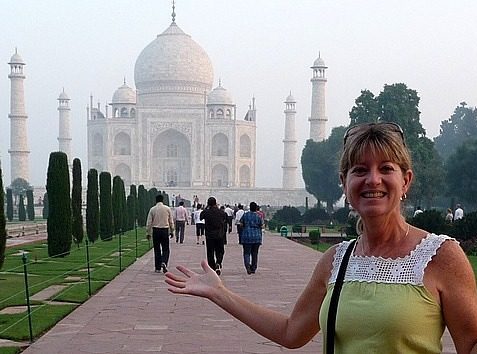Tuesday was another glorious sunny day, albeit very hot and sticky. I spent the morning wandering around the Pelourinho area and took in the Museu Afro-Brasileiro, which included artifacts from Bahia State’s slave days, including pottery, weavings, wood carvings and other artwork. Someone the art was more modern, depicting the the slave trade and the “experiences” of the enslaved. I also saw the Carnivale Museum, but did not go in.

After I left the Afro-Brasileiro museum, I encountered a group of students conducting tourism surveys. When one of the kids (who spoke English) discovered I was from Seattle, he started trashing me about the Seahawks loss to the Pats in the Super Bowl. Turns out the kid was a Pats fan. At that point, I had to ask if they really wanted me to complete the survey. Little butthead!


Anyway, I ended up meeting Fernando just before 2:00 for our tour of the lower town of Salvador, including the beautiful waterfront. First up was, of course, a church. The Igreja Nossa Sephora do Bonfim, located on the Itapagipe Peninsula, is one of the most famous churches in Bahia and renowned for its healing powers. Everywhere you go in Salvador, people try to give you fitas (coloured ribbons), which are a symbol of the church. When you visit the church, you are instructed to tie the ribbons to the fence surrounding the church with three knots. As you tie the knots you make three wishes. In addition, the folks giving out the ribbons try to get you to tie the ribbon to your wrist with three knots with a similar drill. As the knots are being tied you make three wishes. If you leave the ribbon on until it falls off, your wishes will come true. Cut the ribbon off and … beware.


Unfortunately when we reached the church there was massive reconstruction work going on to the interior of the church and the surrounding areas so it was hard to really appreciate the beauty of the church. Nevertheless, I received a blessing from some person outside the church and we also were able to take in the most important part of the church, the Miracle Room, where people leave pictures, notes and wax body parts (really) seeking miracles. In addition, there are notes and pictures left of people who have have been the recipient of miracles.
After the visit to the church, we moved to the waterfront where we visited the Fort Monte Serrat, one of four 16th century Portuguese waterfront forts still standing (complete with cannons that I know my brother-in-law Don would have loved). The fort retains all of its original structure, including lookout points and domed turrets. The fort was the scene of many battles, including a 17th century battle against the Dutch who did an end around Itaparica Island to avoid detection, but were ultimately defeated by the Portuguese defending Salvador.
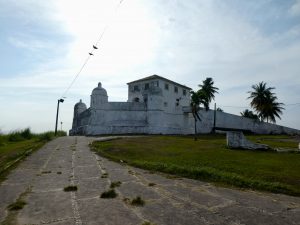
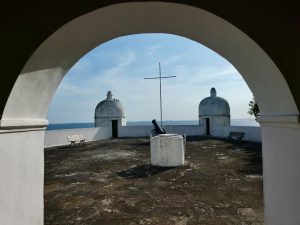

Now while it was really interesting to visit the fort, the real star was the magnificent views. Because the fort was built up on a hill you could literally see most of Salvador, including All Saints Bay, Bon Voyage Beach below, Itaparica Island and the lower city. And the breeze at the top of the fort made for a wonderful respite from the heat and humidity that had enveloped Salvador since I arrived.
After the fort visit, we drove to the Barrera district, which is Salvadore’s waterfront area where we visited three other Portuguese forts. Our first stop took us to the original landing point of the Portuguese marked by, what else, a cross next to Porto da Barra beach. In addition, a recent painting of the landing has been added to the site. Unfortunately, it was hard to get close to the painting because the local men like to use the corner near the painting as a “pee corner” and despite the fact the area is cleaned daily it still reeked. Fernando had no idea why they use the corner, but efforts to stop it have not been successful. (I thought maybe it was their way of showing displeasure with the Portuguese who enslaved many of their ancestors….)


Anyway, right above the landing spot was the Fort of São Diogo also constructed in the 16th century. We did not go inside the fort, but apparently the fort was constructed to prevent the landing of any enemy and access to the south of the city of Salvador.
We then walked along the boulevard past the throngs on the beach below as well as the myriad of portable cart beer vendors. Yep, that is a thing here. Our next stop was the 17th century Forte Santa Maria that still bears the Portuguese emblem and crown above the entrance. This fort was made of stone and lime and also had similar designs to the first fort we visited with domed turrets. From this fort, we could see all four surviving forts, including the Monte Serrat fort located on the far off Itapagipe Peninsula.


We wandered around the fort taking in the views and watching some young guys jumping into the water from a nearby ledge and other folks fishing the waters. There were so many people hanging out and just enjoying the day, I could have easily called it good, pulled up a chair and grabbed a beer, but instead we got back in the car and drove to the last fort, the 16th century Fort of Santo Antônio da Barra, which is actually a lighthouse and building that now houses a Maritime Museum. The fort is notable for the fact that it was the first fort constructed along the waterfront and was at one time taken by the Dutch before the Portuguese recaptured the fort and expelled the Dutch once and for all.
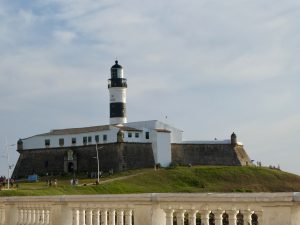
The lighthouse at the fort is the oldest lighthouse in Bahia, dates to the 17th century and still operates to this day. The lighthouse was constructed after a number of shipwrecks in the area.
We then left the waterfront and began the drive back to the Pelourinho district, but along the way we stopped at Dique do Teroro park which had views across to the Copa du Mudai stadium built for the 2014 World Cup and Orixas floating in the lovely waterway that meandered through the middle of the park. Now what are Orixas you ask? Orixas are gods in the Candomblé religion practiced in Salvador and means dance in honour of the gods. As a result, music and dance are important parts of Candomblé ceremonies. Also important is the 16 Orixás. I had seen statutes of these women all around and had no idea what they were until Fernando told me about the religion.
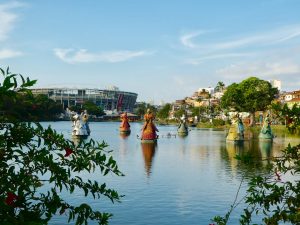
Anyway, after the trip to the park, we road up the hill to the Pelourinho where I was dropped off near the museum I had visited that morning. Fernando was going to meet up with me around 7:00 p.m. for Blessed Tuesdays. Now Blessed Tuesdday is a celebration of the Afro-Brazilian culture and music that occurs ever Tuesday night and begins with a 6:00 p.m. mass conducted at the Nossa Senhora do Rosario Church (the “Black” Church) on Pelourinho Square. The music and celebrating spills out onto the streets and the area percussion groups lead noisy parades through the streets culminating with street music and partying in the bars.
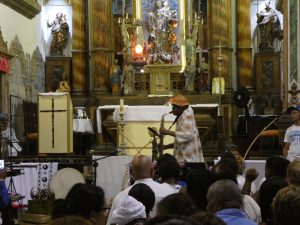
Now the folks in my hotel had advised me that there was going to be some music before the service so I should get their early. Unfortunately, early must have meant well before 5:00 because when I arrived at about 5:35, the place was packed and people were spilling out onto the street. The music had already started and featured what I would call gospel singers, some jazz and of course, the percussion group. Fortunately, the standing folks only stayed for a short bit before leaving, and eventually I found my way to the backside of the last pew. And while I ended up standing for the better part of an hour listening to the music and the service, it beat the heck out of where I started out on the street.
Anyway, after the music supposedly ended, the service started at about 6:10, but quite frankly the music never really ended. The service began with music and singing and a parade down the aisle led by a bishop carrying a cross and the priest wearing green robes, swinging an incense burner back and forth and making an entrance like a rock star. Seriously. Fortunately, I got some of it on film. It was unbelievable.
Now on the left side of the church a small band played percussion and Afro-Brazilian rhythms throughout the Mass. And along with the music, folks were singing and waving their arms back and forth. It was very similar to the service I attended at a black church in Houston, Texas back in 1984. This was something to behold. The music was absolutely incredible.

And the service was apparently being conducted in Portuguese and the West African Yoruba language. I had no clue what was going on, but at one point everyone started hugging me. I stayed for about 45 minutes of the service and finally left when I realized that the Priest was starting his sermon.
After I left, I proceeded back through Pelourinho Square and could not figure out what was going on. Everywhere I looked there were capoeira events taking place, and there was a massive poster hanging from a building that read Moa Vive. (Capoeira is a form of Afro-Brazilian martial arts that combines dance, acrobatics, and music.). Now I knew that vive meant “lives” so I was left to wonder what Moa was. Fernando soon cleared up the issue. Apparently a young man named Moa, who was a leader in the capoeira community was murdered last week when he got into a dispute in a bar over politics. Brazil is in the middle of a bitter election with their version of Donald Trump and a liberal candidate in a runoff election at the end of the month. Salvador is heavily liberal and are very fearful of the right wing candidate.)


Anyway, the gathering of people performing capoeira was meant to celebrate the young man’s life, but as we stood and watched and the crowds got bigger, it was clear this was going to be much more than that. There were TV cameras everywhere and over time, speeches seemed to be getting louder and angrier, which Fernando confirmed.


We finally decided that the music part of the night was either going to be delayed or replaced by the anger, so Fernando and I went off looking for music elsewhere. Near the San Francisco Church we found a group singing Spanish songs (at least I could understand some of it) so we stood and watched that for a bit.
We then wandered down the street to watch a couple other bands in bars, before walking back to the square. There was some music playing now, but then the speeches started back up so I told Fernando I was done. I was really disappointed because I wanted to see the percussion parade. I said my goodbyes and thanks to Fernando and went upstairs to my room. I figured I would pack and then go downstairs for dinner in the lovely restaurant. However, as I was packing, I started to hear drums and pretty soon the drums got louder and louder. Could it be ….?
I grabbed my camera and ran downstairs just in time to see the percussion parade start to pass right in front of the hotel, including the famous Olodum Percussion Band featured in Michael Jackson’s video. It was loud, loud, loud and fantastic. I stood and watched for about 5 minutes as the parade passed by. Simply awesome!
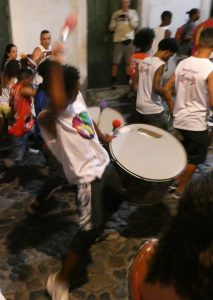
Once the parade had passed, I grabbed some dinner and got ready for bed. I had thoroughly enjoyed my time in Salvador, but it was now time to head to the Pantanal and find some jaguars!
